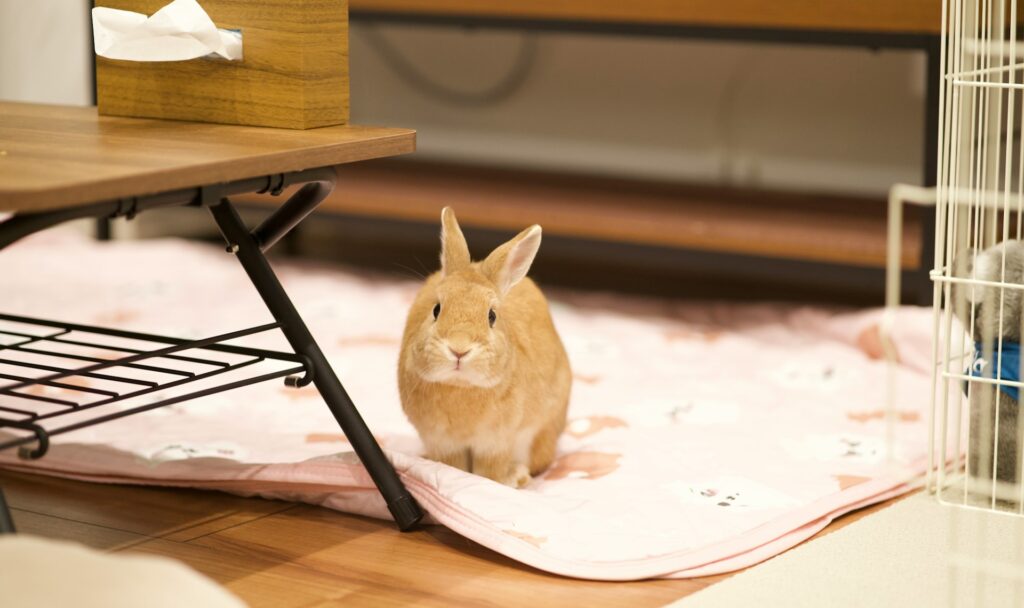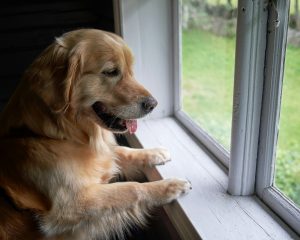3. Litter-Train Fast: Pair the Litter Box with the Hay “Kitchen”
The simplest path to a tidy rabbit apartment setup is to leverage natural habits. Most rabbits eliminate while eating hay, so place a high-back corner litter box directly under (or beside) the hay rack. Line it with paper-based pellets (not clumping cat litter), add a thin layer of hay on top, and keep the rest of the pen free of loose hay so the box is the most attractive “toilet.” When accidents happen elsewhere, move a few soiled droppings into the box to reinforce the scent cue.
Keep the box roomy, with easy in/out access; swap the top layer daily and do a full refresh several times per week. Wipe the plastic with diluted white vinegar, rinse, and dry thoroughly. If you notice odor between changes, increase hay refresh frequency and improve airflow (see Tip 10 later). For whole-home freshness beyond the pen, use tactics from our apartment odor-control guide.
4. Protect Floors and Baseboards (Lease-Friendly, No Tools Required)
A renter-safe setup starts with a waterproof foundation. Place the pen on a vinyl runner, coroplast sheet, or washable mattress protector that extends a few inches beyond the perimeter to catch drips and hay. Add a low-pile rug or carpet tile inside for traction during zoomies and binkies. Along the walls, use clear acrylic or coroplast strips at nibble height to shield paint and baseboards—held with removable Command strips so you don’t leave marks.
Tuck cords up and behind furniture, and route any nearby cables through rigid cord channels. If your rabbit free-roams part-time, block “temptation zones” (door frames, corners) with inexpensive foam edging or moveable storage cubes. For renter-safe ideas across the apartment, see our pet-proofing tips.
5. Set a 3-Minute Daily Refresh and a 20-Minute Weekly Reset
Short, consistent routines beat occasional marathons. Each day, remove wet spots from the litter box, top up hay and water, sweep scatter into a small lidded bin, and wipe the bowl and bottle nozzle. Once a week, do a full litter refresh, launder mats or fleece, and wipe barriers and pen panels. Keep a hand vac, trash bin, spare liners, and paper towels in a vertical caddy beside the pen so everything is within arm’s reach and the whole cadence stays under 20 minutes.
Leave a little familiar scent in hideouts during weekly resets to reduce stress, and schedule deep cleans when your rabbit is engaged with a forage toy in a temporary playpen. For low-cost enrichment to keep them occupied during cleaning, rotate simple options from our DIY toys roundup.
6. Create a Safe Free-Roam Route You Can Set Up in 60 Seconds
Even with a roomy pen, rabbits need daily out-of-pen time. Pre-plan a simple “track” you can deploy quickly: use x-pen panels to fence off a hallway loop or living-room perimeter, roll out a low-pile rug for traction, and block cable clusters with storage cubes or a bench. This lets your rabbit sprint, explore, and return to the pen without slipping on hard floors or finding trouble in corners. Keep the route consistent so your rabbit learns the boundaries and settles faster.
Store the panels vertically behind a bookcase or sofa with two Command hooks so setup takes under a minute. If you have door thresholds, add a thin runner over them for confident crossings. A predictable free-roam layout reduces stress and helps your rabbit apartment setup stay tidy—less scatter, fewer chew temptations, and calmer energy at night.
7. Manage Sound and Vibration for Quiet Nights (and Happy Neighbors)
Rabbits aren’t wheel-runners, but they can thump and do late zoomies. Place the pen on a rug or cork tiles to dampen vibration, and keep it off shared walls. Schedule free-roam and play right after your dinner hour so your rabbit is more likely to rest at bedtime. Avoid placing rattly items (wire hay racks, metal bowls) where they clank; use ceramic bowls and a sturdy litter box so movement stays quiet.
If your home is echo-prone, a small white-noise machine outside the pen smooths ambient sounds without blowing air on your rabbit. At night, dim the room slowly instead of a hard lights-out—gradual cues help rabbits settle. Pair this with Tip 5’s quick refresh so there’s nothing smelly or stimulating to investigate after midnight.
8. Rotate Enrichment: Forage, Dig Boxes, and “Job” Toys
Bored bunnies chew baseboards. Give them a rotating “job list”: scatter-feed part of their hay and pellets in cardboard tubes, offer a shredded-paper dig box inside a shallow storage bin, and add willow balls or apple-wood chews to redirect teeth. Create two hideouts with different feels (one cardboard, one covered crate) so they can choose privacy or watchfulness. Swap two or three enrichment items weekly to keep curiosity high without filling your space with clutter.
Keep all enrichment within your planned zones: foraging near the litter+hay “kitchen,” dig box on a mat, chews away from wall edges. This zoning keeps mess localized and reinforces good habits. For budget-friendly ideas, you can draw from our DIY list later in the post without adding visual noise to the room.
9. Dial In the Hay & Water Station for Less Mess (and Better Eating)
In a tidy rabbit apartment setup, the hay zone does the heavy lifting. Mount a sturdy rack just above a roomy, high-back litter box so stray strands fall into the box—not across your carpet. Keep the rack at nose level so your rabbit doesn’t crane upward, and top it with fresh hay daily; frequent refreshes encourage grazing and reduce odor. For water, use a heavy ceramic bowl (quiet, natural posture) or a bottle with a drip catcher—park a small tile or cork square beneath the nozzle to protect mats from splashes.
Separate pellets from the hay area by a few steps so your rabbit has a reason to move around the pen. If you notice soggy corners, rotate the litter box 90° and shift the rack an inch—small position changes often fix scatter. For apartment-wide freshness beyond the pen, borrow tactics from our odor-control guide.
10. Keep Climate Stable: Gentle Airflow, No Drafts, No Direct Sun
Apartments swing from stuffy to breezy quickly, so aim for even, gentle airflow. Place the pen several feet from windows, heaters/AC vents, and exterior doors; use sheer curtains to soften bright sun and prevent hot patches on flooring. If the room is stale, angle a small fan on low to move air past (not into) the pen—fresh circulation helps dry litter faster and reduces musty smells without chilling your rabbit.
A simple thermometer-hygrometer helps you catch patterns like late-afternoon heat or overnight dips. Adjust curtains, fan angle, or room choice based on the readout. Pair climate control with a predictable daily routine (Tip 5) and pre-bed free-roam (Tip 7) so nights stay quiet and relaxed.
11. Bunny-Proof Beyond the Pen: Cables, Corners, and Furniture Layout
Free-roam time is where deposits are won or lost. Route cables up the back of furniture and into rigid cord channels; keep power strips inside a lidded cable box. Slide bookcases and consoles tight to the wall to block access behind them, and protect baseboard edges with clear acrylic or coroplast strips held by removable tabs. Give your rabbit legal outlets for chewing—willow balls, apple-wood sticks, cardboard “logs”—and rotate them weekly so curiosity has a safe target.
Designate a consistent free-roam loop (Tip 6) and keep fabrics, tassels, and plants out of chewing range. For more renter-safe tactics across the home, see our pet-proofing tips. Thoughtful layout plus chew-redirects keeps your space intact and your rabbit content.
12. Plan for Pairs: Neutral-Spot Bonding and Duplicate Resources
Many rabbits thrive with a bonded partner, but introductions should be slow and structured. Start with visual/scent exposure in side-by-side pens, then move to a truly neutral spot (a bathroom or hallway you’ve never used for either rabbit) for short, supervised sessions. Keep the area minimal—no corners to trap, two boxes to hop onto, and a long “escape lane” so passing is easy. Watch for relaxed body language (grooming, loafing near each other) before extending session length.
When co-housing, offer duplicates of everything: two hay piles, two water sources, two litter boxes, and at least two hideouts with wide front openings. Spread resources far apart to reduce guarding. After a calm neutral session, move both rabbits into a freshly cleaned main pen at the same time so neither “owns” it. Keep your daily refresh (Tip 5) consistent—predictability lowers tension and keeps a shared rabbit apartment setup quiet and tidy.
13. Make a One-Bin Grooming & Health Check Station
A compact caddy keeps upkeep fast and renter-friendly. Stock a nail clipper, styptic powder, a soft slicker brush, a lint roller, pet-safe wipes, cotton pads, and a small flashlight for quick paw/ear checks. Add a folded towel (for a stable lap perch) and a rubber-backed mat so your rabbit has traction. Park the bin beside the pen so weekly touch-ups take minutes—trim nails, brush loose fur, wipe the litter box rim, and check for damp chin or bottom (signs you may need to adjust water height, litter, or diet).
Keep sessions calm and short; end with a small forage reward in the pen so grooming predicts something positive. If you’re doing free-roam afterward, run your usual 3-minute tidy (Tip 5) first—clean floors plus a settled routine equal quieter evenings and fewer “investigations” of off-limits corners.
14. Make It Lease-Friendly: Removable Fixes, Floor Protection, and Quiet Gear
A polished rabbit apartment setup should look intentional and landlord-safe. Place the pen on a waterproof base (vinyl runner, coroplast sheet, or washable mattress protector) that extends a few inches beyond the perimeter to catch hay, drips, and scatter. Use low-pile rugs or carpet tiles inside for traction and sound damping. Mount hay racks, guards, and organizers with removable Command strips or hooks so your walls stay pristine. Choose ceramic bowls and sturdy litter boxes to prevent rattles at night, and add felt/rubber pads under the pen stand to stop vibration transfer through floors and shared walls.
Keep a tiny “move-out” checklist on your phone: patch nail holes, remove adhesive tabs slowly with heat if needed, wipe barriers with diluted vinegar, and run an extra laundry cycle for mats and liners a week before inspection so the space smells neutral. Lease-friendly choices now protect your deposit later.
15. Pack a Closet-Size “Go-Bag” and Practice a 2-Minute Drill
Small homes demand smart prep. Pack a soft-sided carrier, a folded fleece, disposable pads, a week of pellets, a sealed bag of hay, a collapsible water bottle, nail clippers, styptic powder, and a printed vet/contact list into a single tote. Hang the carrier on a sturdy wall hook with the tote behind it so it takes zero floor space. Do a 2-minute drill once a season: open the pen, guide your rabbit calmly into the carrier with a forage treat, grab the tote, and go. For evacuation checklists tailored to pets, bookmark the Red Cross pet disaster preparedness guide.
Pair that kit with a labeled home bin (spare liners, wipes, extra litter, trash bags) right beside the pen so weekly resets are effortless and the area stays guest-ready.
Final Thoughts
You don’t need a big place to give a rabbit a big life. With smart zoning (litter + hay “kitchen,” hideouts, rest area), renter-safe floor and wall protection, a quick daily refresh, and enrichment that redirects chewing to “legal” targets, a rabbit apartment setup becomes quiet, clean, and easy to maintain. Add a predictable free-roam loop, gentle airflow, and a compact go-bag, and your home stays calm and landlord-approved—while your bunny gets room to hop, explore, and relax right alongside you.
Frequently Asked Questions
What should a rabbit apartment setup include?
A roomy x-pen or gated area with a waterproof base, a litter + hay “kitchen,” two hideouts, non-slip rugs for traction, heavy ceramic food/water dishes, and a few safe chews. Add gentle airflow (no drafts), a predictable free-roam loop, and a quick daily refresh so the space stays clean and quiet.
How do I litter-train a rabbit in an apartment?
Pair the litter box with the hay rack—most rabbits eliminate while eating. Use a high-back box with paper-based pellets, place a thin hay layer on top, and confine early to a smaller zone. Move stray droppings into the box, reward correct use, and spot-clean daily. Wipe the box with diluted vinegar during full refreshes.
How do I stop chewing on cords and baseboards?
Route cables up the backs of furniture into rigid cord channels and use a lidded cable box at power strips. Shield baseboards with clear acrylic or coroplast held by removable tabs, and slide furniture tight to walls. Provide “legal” chews (willow balls, apple-wood sticks, cardboard) and rotate them weekly. For renter-safe ideas, see our pet-proofing tips.
How much space and free-roam time does a house rabbit need?
Aim for a generous, rectangular pen (for example, about 4×6 ft or more) with daily free-roam. What matters most is uninterrupted floor area for hopping, clear routes between zones (litter + hay, rest, hideouts), safe traction, and time out of the pen to explore. Keep the layout consistent so your rabbit relaxes and returns to the litter zone by habit.
How do I control rabbit odors in a small apartment?
Refresh the litter box frequently, top up fresh hay daily, and keep airflow gentle but steady. Do a 3-minute daily tidy (scoop, wipe bowls/nozzle, sweep scatter) and a 20-minute weekly reset (full litter change, wash mats/fleece, wipe panels). For whole-home freshness, use strategies from our apartment odor-control guide.






